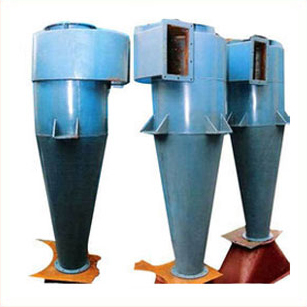


The purpose of a cyclone separator is to separate solids (in granular or powder form) from gases and air. The solids are separated as the material is moving, as in pneumatic conveying. This device rotates a cylindrical tank of appropriate design while forcing air to flow at cyclonic speed. While air maintains its high speed because of its velocity factor, solid materials absorb centrifugal force and choose to adhere firmly to the outer surface when they reach high speeds. An air outlet is abruptly supplied in the center to allow air to exit, but the solid material is unable to shift direction and instead descends and separates due to centrifugal force. Up to 90% separation efficiency can be achieved with this device, while this obviously depends on the design, material, bulk density, etc. Material is gathered in a single collecting hopper.
A Cyclone Separator is a mechanical device used to remove particulates from air, gas, or liquid stream without the use of filters. It works on the principle of centrifugal force, making it highly effective for separating solid particles from fluids.
A cyclone separator works on the principle of centrifugal force to separate solid particles or droplets from a gas or liquid stream. The dirty gas or air enters the cyclone tangentially at high velocity. This creates a spiral (vortex) motion inside the cylindrical chamber.
Due to the tangential entry, the gas spins rapidly along the wall, creating a strong centrifugal force. Heavier particles or droplets are thrown outward toward the wall. As particles hit the inner wall their kinetic energy drops. They slide downward by gravity and move toward the dust collection chamber. The cleaned gas continues spiraling downward in an outer vortex. Near the bottom, the gas flow reverses and moves upward, forming an inner ascending vortex. This clean gas then exits through the central outlet pipe (vortex finder) at the top. Separated particles fall into the dust hopper at the bottom, from where they are removed manually or via an automated system.
Cyclone Separators operate without mechanical components, resulting in low maintenance, high reliability, and long service life. They have high dust collection efficiency and can remove medium to coarse particles from air or gas streams. Efficiency improves with higher particle size, density, and inlet velocity.
Cyclone Separators are made from steel, stainless steel, or abrasion-resistant materials to withstand harsh industrial environments. They require no filters, bags, or power for operation, except for the fan/blower. Simple design reduces operational expenses.
Cyclone Separators can handle high-temperature gases and high-pressure conditions, making them suitable for boilers, furnaces, and kilns. They are often used as pre-cleaning device before bag filters, scrubbers, or electrostatic precipitators to reduce dust load.
Due to their Compact and Space-Saving Design, Cyclone Separators are easy to install in existing systems. Cyclone Separators are available in single or multiple cyclones, suitable for varying flow rates and dust loads.
Cyclone Separators are used in Versatile Applications like